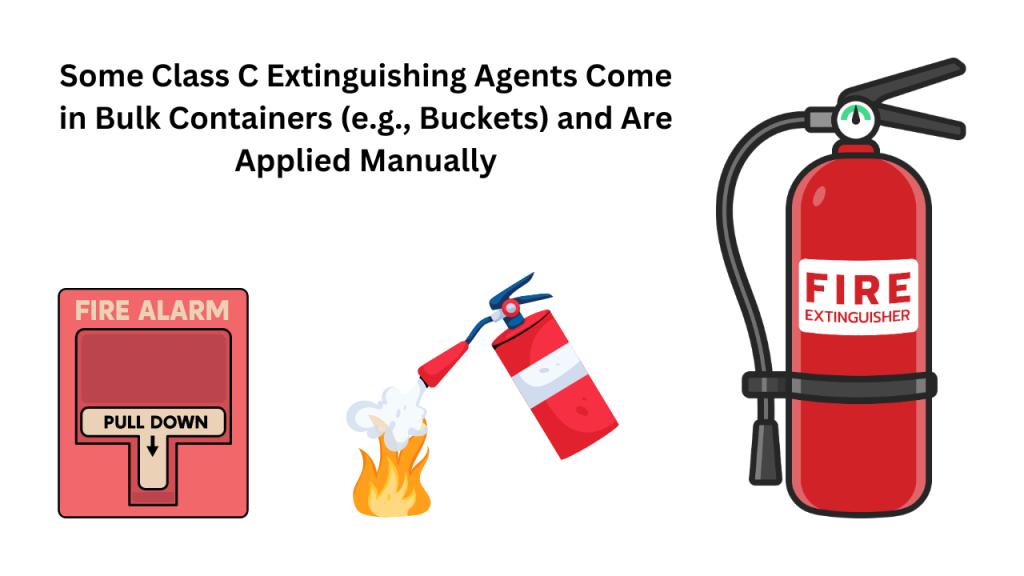 Some Class C Extinguishing Agents Come in Bulk Containers (e.g., Buckets) and Are Applied Manually
Some Class C Extinguishing Agents Come in Bulk Containers (e.g., Buckets) and Are Applied Manually
Imagine you’re in a situation where an electrical fire has broken out. You might reach for a fire extinguisher, but did you know there are specific extinguishing agents for electrical fires that come in bulk containers like buckets? These Class C extinguishing agents are applied manually, and understanding how to use them can be a lifesaver. Let’s dive into the world of manual fire-fighting techniques and discover why these methods are essential for handling electrical fires.
What Are Class C Extinguishing Agents?
Class C fires involve electrical equipment, making them distinct from other types of fires. Class C extinguishing agents are specifically designed to combat these fires without conducting electricity. These agents include dry chemicals like sodium bicarbonate and potassium bicarbonate, as well as non-conductive liquids. They work by interrupting the chemical reaction of the fire, effectively smothering it and preventing re-ignition.
Why Are Bulk Containers Used for Class C Extinguishing Agents?
Bulk containers, such as buckets, offer several advantages when it comes to extinguishing electrical fires. Bulk containers provide a large quantity of extinguishing agent, making them ideal for bigger or multiple fire sources. They are also cost-effective and can be easily stored and transported. When manual application is required, having the agent in a bucket allows for quick and flexible deployment.
How to Use Class C Extinguishing Agents from Bulk Containers
Using extinguishing agents from bulk containers requires some know-how. Here’s a step-by-step guide:
- Identify the Fire Type: Ensure the fire is indeed a Class C fire. If the fire involves energized electrical equipment, it’s classified as Class C.
- Turn Off the Power: If it’s safe, turn off the power source to the affected equipment to prevent further electrical hazards.
- Apply the Agent: Using a scoop or shovel, apply the extinguishing agent generously over the fire. Ensure you cover all affected areas.
- Monitor and Repeat: Keep an eye on the fire. If it reignites, apply more of the extinguishing agent until the fire is completely out.
The Importance of Proper Training
While it might seem straightforward, using manual fire-fighting techniques requires proper training. Without adequate knowledge, you might not apply the agent effectively, or worse, put yourself in danger. Many fire safety training programs include modules on using bulk extinguishing agents, ensuring that individuals are prepared to handle these situations safely.
Advantages of Manual Application
Manual application of Class C extinguishing agents offers several benefits:
- Flexibility: You can apply the agent precisely where it’s needed, ensuring better coverage.
- Control: Manual application allows for controlled use of the agent, minimizing waste.
- Accessibility: Bulk containers can be placed strategically in high-risk areas for easy access.
Comparing Bulk Containers to Traditional Extinguishers
Traditional fire extinguishers are more common, but bulk containers have unique advantages:
- Capacity: Bulk containers hold more extinguishing agent, making them suitable for larger fires.
- Cost: They are often more cost-effective, especially for industrial or commercial settings.
- Versatility: They can be used in various ways, from direct application to filling other containers.
Safety Precautions When Using Bulk Extinguishing Agents
Safety is paramount when dealing with fires, especially electrical ones. Here are some key safety precautions to follow:
- Protective Gear: Always wear appropriate protective gear, including gloves and safety goggles.
- Ventilation: Ensure the area is well-ventilated to avoid inhaling any harmful fumes.
- Distance: Maintain a safe distance from the fire while applying the agent.
Real-Life Applications of Bulk Extinguishing Agents
Many industries rely on bulk extinguishing agents for fire safety. For example:
- Power Plants: Electrical fires in power plants can be devastating. Bulk containers allow for rapid and effective response.
- Data Centers: Protecting sensitive equipment from fire damage is crucial in data centers. Manual application ensures precision.
- Manufacturing Facilities: Factories with heavy machinery often face electrical fire risks. Bulk agents provide a practical solution.
The Future of Fire Safety: Innovations in Extinguishing Agents
As technology advances, so do fire safety measures. Innovations in extinguishing agents are making them more efficient and environmentally friendly. For instance, newer agents are being developed to reduce environmental impact while maintaining effectiveness. Bulk containers are also evolving, with more user-friendly designs and improved storage solutions.
Fun Facts About Fire Extinguishing Agents
Did you know?
- Ancient Methods: Ancient Greeks used water and vinegar mixtures to fight fires.
- Fire Grenades: In the 19th century, glass grenades filled with fire-extinguishing chemicals were thrown at fires.
- Space Safety: The International Space Station uses specialized extinguishing agents to handle potential fires in microgravity.
Conclusion: Be Prepared, Be Safe
Understanding and using Class C extinguishing agents from bulk containers can make a significant difference in an emergency. By knowing how to apply these agents manually, you can protect yourself and others from the dangers of electrical fires. Always prioritize safety, seek proper training, and stay informed about the best practices in fire safety. Are you ready to tackle electrical fires with confidence?
By exploring the world of manual fire-fighting techniques, you can be better prepared for emergencies, ensuring safety and peace of mind. Stay safe and proactive in your fire safety measures!
